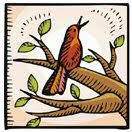Diosppyros virginiana, possum tree, possumwood, common persimmon
I've been thinking about planting a persimmon tree. Persimmon trees are native to this area (and to the entire southeastern United States.)
Around here, people call them "possum trees" because possums love the fruit and will climb the tree to get it. The fruit is popular with raccoons, skunks, foxes, mice, deer, and various birds as well.
 |
| Persimmon leaf and bark USDA photo |
The tree is a member of the ebony family, and its very distinctive bark helps to identify it when fruit is not present. The bark is black with blocks arranged in a grid pattern. If you look between the plates, you can see an orange coloration (more obvious on younger persimmon trees.) The bark on older persimmons looks like a wooden representation of alligator skin!
Here's something interesting from history about the flavor of the persimmon: Captain John Smith of Jamestown fame wrote in 1607, "...the fruit [the persimmon] is like a medlar; it is first green, then yellow and red when it is ripe: if it is not ripe, it will drive a man's mouth awrie with much torment, but when it is ripe, it is as delicious as the apricot.."
I know where a persimmon tree grows in the backyard of an old store building. I had been thinking about looking around for a seedling or collecting some seed next fall when the fruit drops.
However, I read somewhere tonight that the tree is best propagated with a root cutting. So I don't know! This old store building sits next to someone's house, and maybe they won't want me to dig around in the yard looking for a root! I would have to ask permission even to look for a seedling.
It may be best to just buy a persimmon tree. A cultivar called "Meador" has been selected for sweetness and is available from nurseries.
 Persimmons are not too fussy about where they're planted. They send down a deep taproot, so they can tolerate a dry location. They don't mind heavy soil but they don't like shade. A persimmon should do OK in the site I can offer it, a well-drained south-facing spot on the edge of a broad ridge.
Persimmons are not too fussy about where they're planted. They send down a deep taproot, so they can tolerate a dry location. They don't mind heavy soil but they don't like shade. A persimmon should do OK in the site I can offer it, a well-drained south-facing spot on the edge of a broad ridge.

 "The power to recognize trees at a glance without examining their leaves or flowers or fruit as they are seen, for example, from the car-window during a railroad journey, can only be acquired by studying them as they grow under all possible conditions over wide areas of territory. Such an attainment may not have much practical value, but once acquired it gives to the possessor a good deal of pleasure which is denied to less fortunate travelers."
"The power to recognize trees at a glance without examining their leaves or flowers or fruit as they are seen, for example, from the car-window during a railroad journey, can only be acquired by studying them as they grow under all possible conditions over wide areas of territory. Such an attainment may not have much practical value, but once acquired it gives to the possessor a good deal of pleasure which is denied to less fortunate travelers."
3 comments -- please add yours:
Nicely done. Going with a few cultivars is your best bet if planting a couple. If you want a number of them, you might try buying a bundle of persimmon seedlings from Kentucky State Forestry, then see my links page at persimmonpudding.com for INGA & KNGA and letting people know you're looking for Persimmon scion wood. You can then graft yor own on a number of trees. It isn't terribly difficult and you can get a number of cultivars. Remember to keep some males for pollination.
---
persimmonpudding.com: dedicated to growing, education, and use of Diospyros virginiana L., the common, or American persimmon
http://www.persimmonpudding.com
Thanks for the link you gave to this article on your site.
Just as an update, I did search around on the internet and look through various seed catalogs for persimmon trees.
We tried ordering some seedlings from a small nursery that was very reasonable in price. However, they were sold out at the time of our order. So we ordered a couple of pawpaw trees instead. They are not really a substitute, but they should be interesting.
Maybe next year we'll get our persimmons.
Persimmon trees are male or female, so if you plant seeds you won't know what you are going to get.
Post a Comment